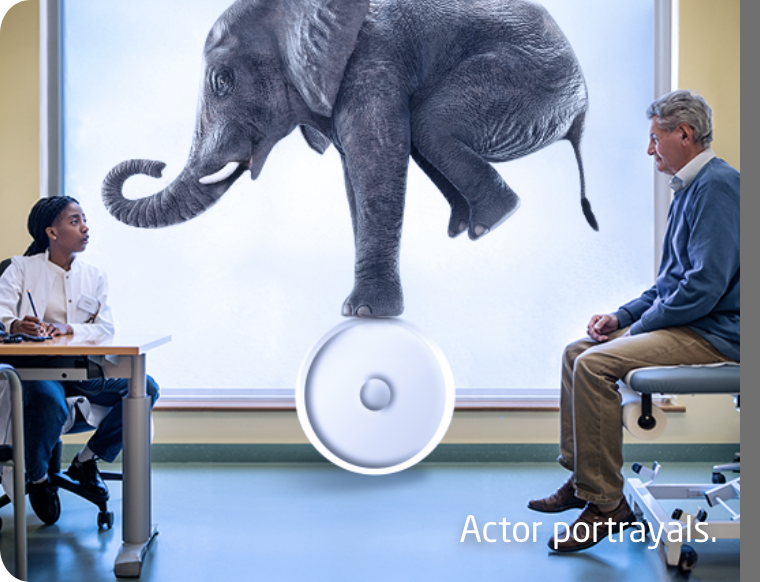The dollars and sense of diabetes tech: How I talk with patients when tech cost is a barrier
By Amy Hess-Fischl, MS, RDN, LDN, BC-ADM, CDCES
8 min read

I’m talking with a new patient: a woman with type 2 diabetes (T2D) who has recently started taking basal insulin. She’s detailing her daily grind as a working mom, and she strikes me as a possible candidate for a continuous glucose monitor (CGM). She’s clearly fed up with finger sticks.
I ask her what she knows about CGMs. She’s heard of them and she’s interested, but I hear hesitation in her voice. I suspect the conversation may soon pivot to money.
With diabetes tech, cost has to be part of the conversation. But I’ve done this long enough to know that if the financial commitment is a barrier, I want her to bring it up. We keep talking, and I ask questions inviting her to talk about what’s stopping her.
Soon she raises her concern, but she doesn’t say, “I can’t afford it.” She asks, “Will it be worth the cost?”
And now we’re having the conversation we both want to have.
Show patients what they’re getting for their money
I think for many patients, their financial concern comes from not realizing the value of using the tech. I try to give these individuals a glimpse of the information different diabetes tech may provide.
Sometimes providing examples may be enough. For instance, I might
- Show my patients a graph of CGM data from a sample Ambulatory Glucose Profile (AGP) report1
- Let them see the precision of a digital insulin dose log compared to a notebook2
- Pull up diabetes management apps on my smartphone and explain their features3

When discussing how much a patient is willing to spend on diabetes tech, help them see the value it may add to their self-management.
But my favorite way to open someone’s eyes to tech is to let them experience it. Fortunately, free trials may let them do that without spending a dime.
I worked with a middle-aged man with T2D, also on long-acting insulin, who was candid about his tight budget. He didn’t want to lay out money to get, as he said, “a bunch of numbers in my face.” To him, diabetes data seemed like a confusing, meaningless fog. Why would he spend his hard-earned money on that? I had to help him see the numbers as something meaningful.
So we started talking about how and what he ate, and I gave him some examples of the “if you do this, then that” relationship between his basal insulin, his food, and his glucose levels. That made sense to him—he liked the idea of being able to see the cause and effect of his actions on his blood sugar.
When I told him that a CGM and a food tracking app might help him see it even more clearly—and when I assured him it wouldn’t cost him anything—he agreed to a 2-week trial of both.

My favorite way to open someone’s eyes to tech is to let them experience it. Fortunately, free trials may let them do that without spending a dime.
After 14 days of logging his meals and looking at how his glucose levels responded, he came back with a completely different opinion of diabetes tech. The first thing he said was, “I had no idea I ate so much!”
He promptly started cutting back his portions at meals, and he saw the difference it made in keeping his glucose levels in their target range. In the longer term, it helped his A1C as well. “Aren’t you impressed?” he said. “I learned something!”
Express empathy for people’s financial stress
There’s no getting around the fact that tech can be expensive. When suggesting tech, I think about facing the same challenges as my patients. I don’t have diabetes, but there have been times in my life when I’ve felt stressed about money. As a provider, I try to keep that feeling front of mind when we talk about making tough financial decisions.
I always remind myself to take their financial situation into account. I’ve had frustrated patients tell me their primary care providers don’t know what they go through with money. Patients facing financial challenges sometimes tell me that when providers talk about tech as if it’s free, or if they downplay the cost, they may lose trust or question whether the provider understands their needs.
The flip side of that is when providers assume their patients can’t afford technology. They might not even recommend it, making people feel excluded from the decision-making process.4 Either way, I think it shows a lack of empathy from the providers.
I believe we as providers need to show our patients the value of diabetes tech, but we also need to acknowledge the real financial impact it can have. When patients tell me about their financial concerns, I might reply by restating what they’ve said. I want them to know I’m listening and I’m on their side.

I don’t have diabetes, but there have been times in my life when I’ve felt stressed about money. As a provider, I try to keep that feeling front of mind when we talk about making tough financial decisions.
Crunch the numbers
I want to know what real dollar amounts mean to my patients. Can they afford $50 a month? What about $20? Or $10? What might they have to give up to make that copay fit their budget?
When we’re having these conversations, I think it’s important for me to tell them how much the tech may cost. I like to know the going rate for any tech I recommend, including any monthly supplies, and I try to keep current with options for less expensive pharmacies or supply vendors.
Whenever possible, it helps to familiarize myself with each patient’s insurance coverage before meeting with them. I do my best to stay current with insurers’ typical coverage for diabetes devices—major commercial insurance providers, Medicaid in my state, and Medicare. There are too many different plans for me to learn them all, so I do my best to estimate general cost compared with cash pay prices. I also provide my patients with resources such as Medicare.gov/coverage to find out their coverage for CGMs.
And I’m always on the lookout for manufacturers’ savings offers, free trials, and rebates. The Association of Diabetes Care and Education Specialists (ADCES) maintains a list of cost-saving resources for diabetes tech that my patients find helpful. Any relief I can provide, even if it only saves them a few dollars, can help assure my patients that I’m taking their financial concerns seriously.

Savings offers, free trials, and shopping around for competitive prices may add up to meaningful savings on tech for people with diabetes.
Collaborate and problem solve your way to a plan
An endocrinologist referred a patient with T1D to me whom he felt was a good candidate for an automated insulin delivery system, or at least a CGM and insulin pump. But the patient refused to discuss it. He was 23 and had been using a glucose meter and injecting insulin since childhood.
When I spoke with him, he pointed out that he wasn’t opposed to tech on principle. He simply said, “I’m not willing to shell out cash when what I’m already doing is working.”
I believed him that he felt fine, but I wondered if he might be using the cost as a reason not to consider anything else.
I asked him what price range would make him willing to try a CGM. He gave me a number, and we found a vendor where he could buy CGM sensors for less than that figure. He’s now using a CGM and making connections between his glucose levels and how he feels.
When I asked him about an insulin pump, we went through the same discussion. The pump is a bigger initial investment, so he’s still debating whether he’ll move forward with it. He wants to see if he can be satisfied with the CGM and multiple daily injections.
I see that as a win. He’s weighing the cost and benefits of each device, thinking critically. Money isn’t a total roadblock anymore. He’s figuring out what will work best for him, and the price is just one factor in his decision.

I believed him that he felt fine, but I wondered if he might be using the cost as a reason not to consider anything else.
Everyone has their own comfort level with change. One person may agree to try a device or an app for a specified period. Another may compromise by wearing a CGM intermittently rather than all the time. A third person might get creative with budgeting—finding a recreational activity they can cut back on or a monthly subscription they’re willing to cancel.
If I think a piece of tech may help someone, I’ll gladly work with any efforts they’re willing to make.
Tactful talk: What to say, what not to say
Based on my experience, here are some suggestions for talking with patients about tech cost. This is what works for me and what doesn’t. Your conversational approach may vary. Click the (+) for details.
Before bringing up cost, ask them what they think of their current self-management. Find out what they feel is missing and what’s keeping them from making a change. Encourage them to elaborate whenever possible.5
Telling someone they have to spend money on tech may make them feel pressured and could negatively affect the patient-provider relationship. Find their comfort level and work within it.5
Put yourself in their shoes, try to understand their concerns, and let them know they’re in a judgment-free zone. Be respectful of each person’s financial situation. Reflect their concerns back to them so they know they’ve been heard.5
Avoid saying things like, “it’s not that expensive.” Affordability is relative. Patients are the ones who will feel the stress of a new tech expense, and it may strain their budget, regardless of the amount.
Talk them through realistic evaluations of their monthly budget with hard numbers at hand. Know the prices of the tech you’re recommending.6 Ask them to think through spending the money and how it might affect their budget in the short and long term. In my experience, this may help them see a path to adopting tech.
Don’t lead the conversation with, “you probably can’t afford this.” Instead, ask about what’s keeping them from trying the tech.5 Leave space for the patient to tell you what their limits are and let them be the judge of what they can afford.
If someone is interested in tech but can’t fully commit financially, find out what they’d feel comfortable with. You might try asking if they’d be open to short-term or intermittent tech use. Express support and encourage any change they’re willing to attempt.5
Diabetes tech is rarely a one-time expense. Patients should only use tech as long as it’s helping and they can afford it. If their needs or financial circumstances change, they may have to adapt. Include check-ins at each appointment.
Give patients websites, phone numbers, and other necessary contact info for financial resources. If you have a staff member at your practice who handles financial guidance, introduce the patient to them.
After you discuss tech and cost, don’t give them a reason to put it on the back burner. Schedule a follow-up conversation and give them resources they need to move forward.
Balancing diabetes tech with cost for long-term stability
Money is a concern for many of my patients. The best way I know to help is to acknowledge those concerns up front, talk about what they can realistically afford, and help them identify tech that potentially offers the most value.
The conversation we have today can help them balance their current priorities, and our ongoing relationship can help them work toward the long-term diabetes management goals they want to achieve.
Tech-up Follow-ups
- Look up the prices of common diabetes technology and any savings offers from the manufacturers; compare several options of CGMs, insulin pumps, and app subscriptions.
- Research online and local pharmacies to find out whose prices are the most competitive for diabetes tech and supplies.
- Think about a time in your life when you were under financial stress. Imagine how you would have felt if someone had told you to buy something you couldn’t afford. Remember this feeling when listening to the concerns of patients.

Amy Hess-Fischl, MS, RDN, LDN, BC-ADM, CDCES
Chicago, Illinois
Amy is a diabetes care and education specialist and registered dietitian who sees type 1 and type 2 diabetes patients daily. She oversees their education recognition program and coordinates the Teen and Adolescent Diabetes Transition Program at University of Chicago’s Kovler Diabetes Center. She received the American Diabetes Association’s Outstanding Educator of the Year award in 2022.
Amy Hess-Fischl received a fee from Novo Nordisk for her participation.
–— Recommended for you –—

ARTICLE
The tech-ephant in the room: Unpacking implicit bias in the prescription of diabetes tech
Inequities in access to diabetes tech can have many causes, including clinician bias. Read how one health care professional addresses her own biases and assumptions to work toward equitable care.
By Alicia Shelly, MD, FACP | 6 min read
References
- Czupryniak L, Dzida G, Fichna P, et al. Ambulatory glucose profile (AGP) report in daily care of patients with diabetes: practical tips and recommendations. Diabetes Ther. 2022;13(4):811-821. doi:10.1007/s13300-022-01229-9
- Sy SL, Munshi MM, Toschi E. Can smart pens help improve diabetes management? J Diabetes Sci Technol. 2022;16(3):628-634. doi:10.1177/1932296820965600
- Fu HNC, Wyman JF, Peden-McAlpine CJ, Draucker CB, Schleyer T, Adam TJ. App design features important for diabetes self-management as determined by the self-determination theory on motivation: content analysis of survey responses from adults requiring insulin therapy. JMIR Diabetes. 2023;24(8):e38592. doi:10.2196/38592
- Agarwal S, Simmonds I, Myers AK. The use of diabetes technology to address inequity in health outcomes: limitations and opportunities. Curr Diab Rep. 2022;22(7):275-281. doi:10.1007/s11892-022-01470-3
- Welch G, Rose G, Ernst D. Motivational interviewing and diabetes: what is it, how is it used, and does it work? Diabetes Spectr. 2006;19(1):5-11. doi:10.2337/diaspect.19.1.5
- Patil SP, Albanese-O’Neill A, Yehl K, Seley JJ, Hughes AS. Professional competencies for diabetes technology use in the care setting. Sci Diabetes Self Manag Care. 2022;48(5):437-445. doi:10.1177/26350106221120889
The Diabetes Tech-upTM Podcast
Join our expert cohosts for a series of discussions about how they’re integrating diabetes tech with patient-centered care to help optimize diabetes management.
The Mission of Diabetes Tech-upTM
Diabetes Tech-upTM is sponsored by Novo Nordisk, a global leader in diabetes. We believe that adoption of innovative technologies can help appropriate patients better manage diabetes. Our goal is to provide information to help health care professionals on the front line of diabetes care strengthen their understanding of diabetes technologies and implement them where they can have the greatest impact.



Share: